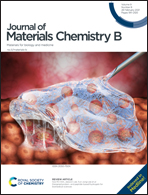Hydrogel composite scaffolds with an attenuated immunogenicity component for bone tissue engineering applications
Abstract
Xenogeneic bones are potential templates for bone regeneration. In this study, decellularized porcine bone powder with attenuated immunogenicity was incorporated into a photocurable hydrogel, gelatin methacryloyl (GelMA), to obtain scaffolds with good mechanical properties for bone tissue engineering. The decellularized bone powder (DCB)–GelMA hybrid scaffolds had higher compressive strength and stiffness values when the DCB content was increased. In vitro evaluations revealed the biocompatibility of these scaffolds. The scaffolds could induce human bone marrow mesenchymal stem cells (hMSCs) to undergo osteogenic differentiation even in the absence of an induction medium. The efficiency of the scaffolds for bone regeneration applications was further evaluated using an in vivo cranial bone defect model in rats. Micro-CT images showed that the hybrid scaffolds with 20% DCB content had the best effect in promoting new bone regeneration. Thus, it was concluded that the DCB–GelMA hybrid scaffolds have high potential in bone tissue engineering applications.



 Please wait while we load your content...
Please wait while we load your content...